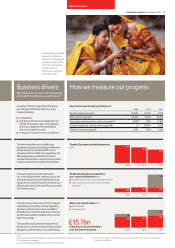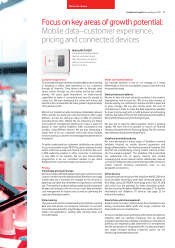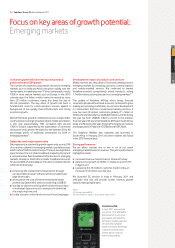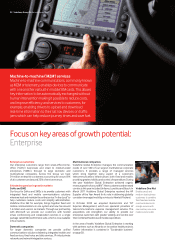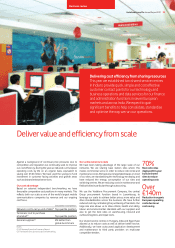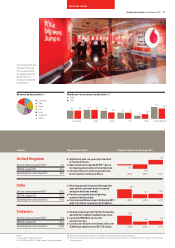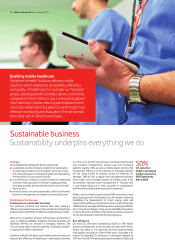Vodafone 2011 Annual Report Download - page 22
Download and view the complete annual report
Please find page 22 of the 2011 Vodafone annual report below. You can navigate through the pages in the report by either clicking on the pages listed below, or by using the keyword search tool below to find specific information within the annual report.
Customer growth will be driven by rising mobile
penetration and GDP growth
The number of customers using mobile services in emerging
markets such as India and Africa has grown rapidly over the
last ten years, increasing by over 17 times compared to nearly
130% in more mature markets such as Europe. In the 2010
calendar year the Indian mobile market increased by more
than 225 million customers, nearly four times the size of
the UK population. The key driver of growth has been a
fundamental need for communication services against a
background of low quality xed infrastructure and strong
economic growth.
Most of the future growth in mobile phone users is expected to
continue to be in emerging markets where mobile penetration
is still only approximately 70% compared with around
130% in Europe, supported by the expectation of continued
strong economic growth. We expect to see between 20 to 40
percentage points of additional penetration by 2014 in
emerging markets(1).
Data is the next major opportunity
Data represents a substantial growth opportunity as only 19%
of our active customers in emerging markets use data services
which is about half the rate in Europe. There are two signicant
opportunities. One is mobile broadband, helped by the lack of
a comprehensive xed broadband infrastructure in emerging
markets. Already in South Africa mobile broadband accounts
for around 90% of all broadband. The other is mobile internet
which we are driving by:
■enhancing the mobile internet experience through
our Opera Mini browser software which provides faster
page downloads;
■driving down the cost of internet enabled handsets
powered by Opera Mini, with prices starting at US$45;
■low day-to-day micro pricing which allows the purchase
of individual data services, for example the download
of a single ring tone; and
■locally relevant content and services in local languages.
Focus on key areas of growth potential:
Emerging markets
Vodafone 252
In April 2011 we launched
one of our most affordable
devices which now comes
pre-loaded with Vodafone
M-Pesa for mobile payment
services and a prepaid
balance indicator that helps
customers to keep track
of their phone credit to
avoid overspending.
Development impact of products and services
Mobile services are a key driver of economic development in
emerging markets by increasing access to communications
and mobile-enabled services. We continued to market
Vodafone-branded competitively priced handsets, selling
1.7 million devices during the year in our emerging markets(2).
The uptake of Vodafone M-Pesa, which brings nancial
services to people without bank accounts, continued to grow,
making an increasing contribution to economic development
in communities that lack conventional banking services. It
now has over 20 million customers globally (11 million in
2010), who transferred around US$500 million a month during
the year (up from US$300 million a month in the previous
nancial year). We launched Vodafone M-Pesa in South Africa,
Qatar and Fiji during the year, bringing the total to six markets,
and began pilots in India with ICICI Bank and HDFC Bank.
The Vodafone WebBox (see opposite) was launched in
South Africa in February 2011 and other markets will follow
in the 2012 nancial year.
Strong performance
We are either number one or two in six of our seven
emerging markets based on revenue. This year’s performance
highlights include:
■increased revenue market share in India and Turkey;
■data revenue growth of 43.8%(*) in Vodacom and 37.7%(*)
in Egypt; and
■surpassing the 134 million customer mark in India, an
increase of 34 million over the year.
We launched 3G services in India in February 2011 and
anticipate that this will provide further revenue growth
opportunities going forward.
Notes:
(1) Source: Informa WCIS.
(2) India, Vodacom, Egypt, Turkey, Ghana, Qatar and Fiji.
20 Vodafone Group Plc Annual Report 2011





